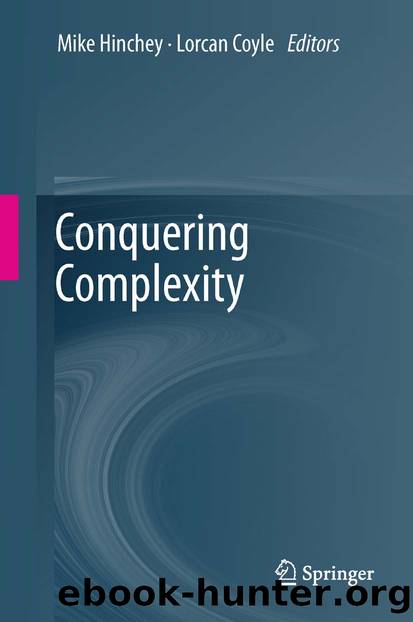Conquering Complexity by Mike Hinchey & Lorcan Coyle

Author:Mike Hinchey & Lorcan Coyle
Language: eng
Format: epub
Publisher: Springer London, London
10.1.3 Agility and Evolution
Separation of concerns and the lowering of the actually felt complexity are particularly important when agility is required and the solution must be able to react flexibly and quickly to new requirements and changed frame conditions. This agility is particularly necessary in areas like business processes, where the ability to change may be business critical. In the aftermath of the 9/11 terrorist attacks in 2001, airlines suffered immense losses because they were unable to adapt their business processes quickly enough to the changed market conditions and demand, ending in huge operational losses and insolvencies. Of course, situations like this are special, but they happen more often than one realizes: after 9/11 the same industry suffered similar crises in the aftermath of the SARS outbreak in 2006, and the Eyjafjallajokull volcanic eruption in 2010. So, there is no doubt that business processes are under the continuous pressure of change and in demand of powerful methods to manage the corresponding process evolution.
We will therefore focus on process modeling, agility, and evolution: How can large End-to-End processes be seamlessly and immediately adapted to new needs? Here is where ideas from eXtreme Programming (XP) enter the picture, and where our One Thing Approach (OTA) has its major impact. We will show how we achieve (a) application-level control, i.e., the continuous involvement of the customer and application/business expert along the entire systems’ life cycle, including software maintenance and evolution, together with (b) continuous and ongoing quality assurance with different means at different levels and phases (requirement validation, simulation, model checking, data flow analysis, testing, and monitoring), and (c) specific support to easily and non-invasively integrate new technologies, in a service-oriented way.
The key to our approach is to view the whole development process simply as a complex hierarchical and interactive decision process, where each stakeholder, including the application expert, is allowed to continuously place his/her decisions in term of constraints, and each development or evolution step can be regarded simply as a transformation of this set of constraints. We use constraints to describe all the pieces of knowledge and information that define and thus restrict the set of behaviors of the system. They comprise temporal constraints, loose process models, symbolic typing, as well as the definition of roles and rights. This allows one to continuously and globally monitor the consistency of the development and of the evolution process via varying forms of constraint checking.
In the remainder of the chapter we will elaborate on these ideas in more detail. Section 10.2 points to the importance of compatibility and interoperability as central meta-constraints of any system, then Sect. 10.3 summarizes the XMDD approach. Sections 10.4, 10.5 and 10.6 sketch our technical solution. Finally we will present some case studies in Sect. 10.7, before we conclude in Sect. 10.8.
Download
This site does not store any files on its server. We only index and link to content provided by other sites. Please contact the content providers to delete copyright contents if any and email us, we'll remove relevant links or contents immediately.
Algorithms of the Intelligent Web by Haralambos Marmanis;Dmitry Babenko(8518)
Test-Driven Development with Java by Alan Mellor(7348)
Data Augmentation with Python by Duc Haba(7249)
Principles of Data Fabric by Sonia Mezzetta(6994)
Learn Blender Simulations the Right Way by Stephen Pearson(6928)
Microservices with Spring Boot 3 and Spring Cloud by Magnus Larsson(6760)
RPA Solution Architect's Handbook by Sachin Sahgal(6166)
Hadoop in Practice by Alex Holmes(6028)
Jquery UI in Action : Master the concepts Of Jquery UI: A Step By Step Approach by ANMOL GOYAL(5869)
The Infinite Retina by Robert Scoble Irena Cronin(5868)
Big Data Analysis with Python by Ivan Marin(5692)
Life 3.0: Being Human in the Age of Artificial Intelligence by Tegmark Max(5397)
Pretrain Vision and Large Language Models in Python by Emily Webber(4652)
Infrastructure as Code for Beginners by Russ McKendrick(4435)
WordPress Plugin Development Cookbook by Yannick Lefebvre(4166)
Functional Programming in JavaScript by Mantyla Dan(4121)
The Age of Surveillance Capitalism by Shoshana Zuboff(4111)
Embracing Microservices Design by Ovais Mehboob Ahmed Khan Nabil Siddiqui and Timothy Oleson(3956)
Applied Machine Learning for Healthcare and Life Sciences Using AWS by Ujjwal Ratan(3929)
